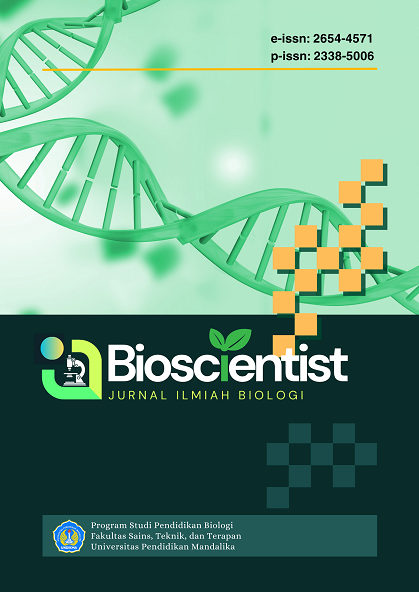Identifikasi Bacillus sp. pada Fermentasi Tapai Singkong
DOI:
https://doi.org/10.33394/bioscientist.v13i3.16707Keywords:
Identifikasi, tapai singkong, Bacillus spAbstract
This study aims to identify Bacillus sp. in cassava tapai fermentation that has potential as a probiotic ingredient. The type of research used is descriptive exploratory using the Standard Plate Count (SPC) method, Gram staining, and biochemical testing with the Microbant System 12B. Cassava tapai samples were obtained by fermenting them for 5 days. Fermentation of cassava tapai was carried out in the Biology Education Laboratory. The results of the study showed that (1) The Standard Plate Count test yielded the highest value on the 4th day of observation at 231x10-2 CFU/ml, while the lowest value was observed on the 1st day at 162x10-2 CFU/ml. (2) Gram staining of the bacterial isolates revealed Gram-positive rod-shaped morphology. (3) Biochemical testing using the Microbant System 12B showed the ability to ferment several types of carbohydrates such as sorbitol, sucrose, lactose, arabinose, adonitol, and salicin, but it cannot ferment inositol, malonate, rhamnose, raffinose, and arginine. Thus, it can be concluded that the bacteria identified from cassava tapai fermentation can ferment in accordance with the physiological capabilities of Bacillus sp.
References
Aini, I. N. (2018). Etnomatematika: Matematika dalam kehidupan petani di Kabupaten Karawang. Teorema: Teori dan Riset Matematika, 2(2), 101–106.
Asnidar, A. (2019). Pemanfaatan isolat probiotik asal tape singkong sebagai antidotum logam merkuri (Hg) pada tikus Rattus norvegicus [Disertasi doktoral, Universitas Hasanuddin].
Banerjee, D., Chatterjee, S., Banerjee, U. C., Guha, A. K., & Ray, L. (2011). Green pigment from Bacillus cereus M 1 16 (MTCC 5521): Production parameters and antibacterial activity. Applied Biochemistry and Biotechnology, 164, 767–779.
Bergey, D. H., & Boone, D. R. (2009). Bergey's manual of systematic bacteriology (2nd ed., Vol. 3). Springer.
Berlian, Z., Aini, F., & Ulandari, R. (2016). Uji kadar alkohol pada tapai ketan putih dan singkong melalui fermentasi dengan dosis ragi yang berbeda. Jurnal Biota, 2(1), 106–111.
Bharti, D., Shivakumar, D., & Sharma, S. (2016). Pigment production by Bacillus subtilis and its biological activities: An eco-friendly approach. International Journal of Pharmaceutical Sciences and Research, 7(12), 4844–4850.
Bidura, I. G. N. G. (2020). Pengaruh probiotik Saccharomyces spp. dalam ransum terhadap kecernaan pakan dan kandungan gas ammonia dalam ekskreta ayam. Majalah Ilmiah Peternakan, 23(2), 84–90.
Erika, D. R. (2022). Uji sensoris dan pH tapai singkong (Manihot esculenta L) dengan fermentasi aerasi. Jurnal Ilmiah, 1(1), 9–15.
Feng, J., Wang, L., Zhou, L., Yang, X., & Zhao, G. (2015). Characterization of Bacillus subtilis strains isolated from fermented soybean products. International Journal of Food Microbiology, 199, 72–81.
Ghahramani, M., Yousefi, R., Khoshaman, K., Moghadam, S. S., & Kurganov, B. (2020). Analysis of the data on titration of native and peroxynitrite-modified αA- and αB-crystallins by Cu²⺠ions. Data in Brief, 30, 105492. https://doi.org/10.1016/j.dib.2020.105492
Liu, X. F., Li, Y., Li, J. R., Cai, L. Y., Li, X. X., Chen, J. R., & Lyu, S. X. (2015). Isolation and characterisation of Bacillus spp. antagonistic to Vibrio parahaemolyticus for use as probiotics in aquaculture. World Journal of Microbiology and Biotechnology, 31, 795–803.
Madigan, M. T., Bender, K. S., Buckley, D. H., Sattley, W. M., & Stahl, D. A. (2019). Brock biology of microorganisms (15th ed.). Pearson.
Manin, F., Hendalia, E., & Yusrizal, Y. (2012). Potensi bakteri Bacillus dan Lactobacillus sebagai probiotik untuk mengurangi pencemaran amonia pada kandang unggas. Jurnal Peternakan Indonesia (Indonesian Journal of Animal Science), 14(2), 360–367.
Mubarak Zaku, S., Chismirina, & Daulay, H. M. (2016). Aktivitas antibakteri ekstrak propolis alami dari sarang lebah terhadap pertumbuhan Enterococcus faecalis. Journal of Syiah Kuala Dentistry Society, 1(2), 171–186.
Pratiwi, W. M., & Asri, M. T. (2022). Isolasi dan identifikasi bakteri indigenous pendegradasi pestisida profenofos dan klorantraniliprol di Jombang, Jawa Timur. LenteraBio: Berkala Ilmiah Biologi, 11(2), 300–309.
Prescott, L. M., Harley, J. P., & Klein, D. A. (2020). Microbiology (11th ed.). McGraw-Hill Education.
Rahayu, E. S., Lioe, H. N., & Utami, T. (2020). Microbial dynamics and metabolite production during cassava tapai fermentation. Indonesian Journal of Agricultural Science, 21(1), 13–22.
Rai, M., Rathod, D., Agarkar, G., & Yadav, A. (2018). Exploitation of bacterial pigment for industrial applications. In Microbial biotechnology for sustainable development (pp. xx–xx). Springer. (Catat: halaman tidak dicantumkan, silakan lengkapi bila tersedia)
Riza, H., Wizna, W., Rizal, Y., & Yusrizal, Y. (2018). Pengaruh level energi dan protein dengan bakteri Bacillus amyloliquefaciens sebagai probiotik untuk mengurangi pencemaran amonia pada kandang ayam broiler. Jurnal Peternakan Indonesia (Indonesian Journal of Animal Science), 20(2), 99–107.
Setiawan, R., Hidayat, T., & Lestari, D. (2021). Karakterisasi bakteri amilolitik dari tapai singkong berdasarkan pewarnaan Gram dan uji biokimia. Jurnal Mikrobiologi Terapan Indonesia, 5(1), 18–24.
Simair, A. A., Qureshi, A. S., Khushk, I., Ali, C. H., Lashari, S., Bhutto, M. A., & Lu, C. (2017). Production and partial characterization of αâ€amylase enzyme from Bacillus sp. BCC 01â€50 and potential applications. BioMed Research International, 2017, 1–8.
Verma, R., Yadav, A. N., Kazy, S. K., & Saxena, A. K. (2021). Bioprospecting of Bacillus strains from extreme environments: Pigment production and their application in agriculture and medicine. Archives of Microbiology, 203(4), 1839–1850.
Wahyuni, I. (2013). Deteksi bakteri caliform dan Escherichia coli pada minuman es jeruk di café lesehan Pantai Talise Palu [Skripsi tidak diterbitkan, Universitas Tadulako].













